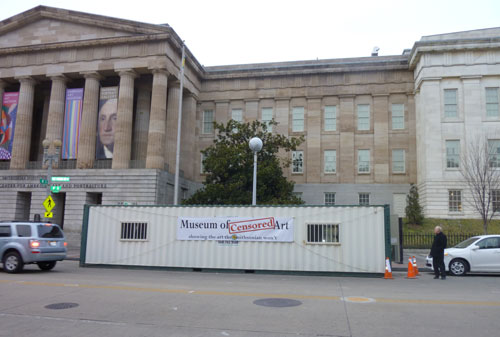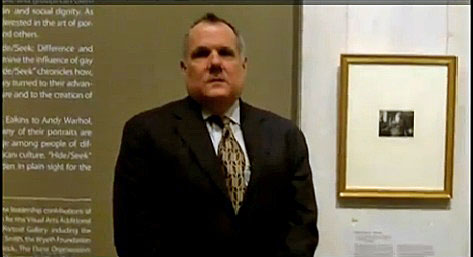
National Portrait Gallery during the run of "Hide/Seek." Out front: a protest show, continuously screening the David Wojnarovicz video removed from the NPG.
The National Portrait Gallery's controversial gay-themed show---Hide/Seek: Difference and Desire in American Portraiture---closed on Feb. 13 as scheduled, not prematurely as museum officials had feared after the exhibition attracted negative notice from two powerful Congressional leaders.
But recent actions by the board of the Smithsonian Institution, which oversees the NPG, may cause the controversy's harmful effects to multiply. An ad hoc committee appointed in the wake of the "Hide/Seek" contretemps by the Smithsonian's Board of Regents recommended a cure that's likely to be worse than the disease. Their prescription would entangle curators at all federal museums in a sticky mess of red tape.
For two months, the Smithsonian's chief executive, Secretary G. Wayne Clough, weathered repeated calls for his resignation from those angered by his Nov. 30 decision to pull the plug on one four-minute video, deemed sacrilegious by some.
The Board of Regents, at its meeting last month, rightly backed the continued leadership of Clough, whose total performance review shouldn't hinge upon one precipitous decision made to shield the institution from more harmful and far-reaching political interference from House Speaker John Boehner, who had threatened to apply his wrath to the Smithsonian's budget. Both he and House Majority Leader Eric Cantor had called for the NPG's show to be shut down.
But if the Regents follow the advice of their three-member ad hoc committee, Smithsonian museums will be buried under a new layer of procedural requirements for public input, activated whenever a cautious curator or museum director flags a proposed exhibition as "sensitive." This bureaucratic blanket will likely have a chilling effect on hot-button shows.
Perhaps most chilling was Clough's suggestion to me, during our conversation in his office last month, that works offending some sensibilities could be off-limits for Smithsonian display in the future. He said that the Smithsonian should have viewed the controversial video---David Wojnarovicz's "A Fire in My Belly"---"through the lens of how someone else would perceive it---as religious desecration. We could have done a better job there. And we will learn from that."
This could be a bad lesson. Artworks are often subject to diverse interpretations. That's certainly the case with the infamous ants-on-a-crucifix moment in Wojnarovicz's video. David Ward, co-curator of the show, told me during a videoed conversation with me at the exhibition that he sees this the controversial 11-minutes Wojnarovicz excerpt as "using the image of the suffering Christ on the cross to exemplify the suffering of people with AIDS and HIV." William Donohue, president of the Catholic League, sees it as blasphemy, calling it "hate speech."
Museum visitors, for the last two and a half months of the show's run, didn't get a chance to draw their own conclusions.
The three-man committee of inside-the-Beltway advisors---John McCarter Jr., a Smithsonian Regent and president and CEO of Chicago's Field Museum of Natural History; David Gergen, senior political analyst for CNN, who served as advisor to four U.S. Presidents; Earl Powell III, veteran director of the National Gallery of Art in Washington---gave lip service to "curatorial freedom of expression, expertise and authority." But from now on, that freedom may be compromised: According to the group's recommendations, professional prerogatives would be second-guessed, in advance, by amateur outsiders and by the Smithsonian's own governing board.
If the committee's recommendations are followed, "public input or reaction" will be sought on "possibly controversial exhibitions" from "a diversity of perspectives." These disparate views would be gathered at the "pre-decisional exhibit planning phases."
Presumably such advance input will need to come from the very people who are most likely to be offended by a particular display. Either the objectors will have to be mollified, or their outrage will be magnified by their having been first consulted, then ignored.
This is clearly a lose-lose scenario.
We're already seeing one form this public input may take: The Smithsonian American Art Museum, whose 2012 show, The Art of Video Games, has already been flagged as possibly controversial because of violent content, recently issued an invitation to the public to vote on what games should be included. The rationale for this, announced by SAAM's director, Elizabeth Broun, is that "playing video games involves many personal choices, so, in keeping with the spirit of the exhibition's content, we want to involve the public in helping us select games for the exhibition." (Presumably, if some critic objects to the choices, she can blame the public.)
In addition to having the laymen looking over their shoulders during exhibition planning, Smithsonian curators would have the Board of Regents breathing down their necks. The committee's recommendations state: "The Regents should be relied upon to provide candid observations and advice on potentially controversial exhibitions" that might "require further Regent engagement." But the proper role of museum board members, who are not art professionals, is to make sure that their institution is well run, not to micromanage curatorial and directorial decisions about what to show and how to interpret it.
The ball was returned to Clough's court. The Regents directed him to "address the panel's observations and recommendations and present an action plan to the Board."
A different type of "action plan" was suggested by Ward of the NPG when we chatted in the galleries during the waning days of the exhibition. Standing in front of a photo of the exhibition's father figure, poet Walt Whitman, the curator suggested a better approach to future contretemps over content.

"Hide/Seek" co-curator David Ward
The Smithsonian's Secretary, he declared, "has to listen to the museum directors....I think that there's been a growth of a bureaucracy on the [Smithsonian's] Mall which has really created a separate institution in the world of museums....The two don't jibe particularly well."